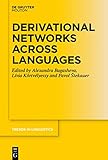Derivational Networks Across Languages / ed. by Alexandra Bagasheva, Lívia Körtvélyessy, Pavol Štekauer.
Material type: TextSeries: Trends in Linguistics. Studies and Monographs [TiLSM] ; 340Publisher: Berlin ; Boston : De Gruyter Mouton, [2020]Copyright date: ©2020Description: 1 online resource (XI, 622 p.)Content type:
TextSeries: Trends in Linguistics. Studies and Monographs [TiLSM] ; 340Publisher: Berlin ; Boston : De Gruyter Mouton, [2020]Copyright date: ©2020Description: 1 online resource (XI, 622 p.)Content type: - 9783110686494
- 9783110686807
- 9783110686630
- online - DeGruyter
- Issued also in print.
| Item type | Current library | Call number | URL | Status | Notes | Barcode | |
|---|---|---|---|---|---|---|---|
 eBook
eBook
|
Biblioteca "Angelicum" Pont. Univ. S.Tommaso d'Aquino Nuvola online | online - DeGruyter (Browse shelf(Opens below)) | Online access | Not for loan (Accesso limitato) | Accesso per gli utenti autorizzati / Access for authorized users | (dgr)9783110686630 |
Frontmatter -- Preface -- Contents -- Abbreviations -- 1 Introduction -- 2 Introduction to Slavic languages -- 3 Derivational networks in Bulgarian -- 4 Derivational networks in Croatian -- 5 Derivational networks in Czech -- 6 Derivational networks in Polish -- 7 Derivational networks in Russian -- 8 Derivational networks in Serbian -- 9 Derivational networks in Slovak -- 10 Derivational networks in Slovene -- 11 Derivational networks in Ukrainian -- 12 Introduction to Germanic languages -- 13 Derivational networks in Danish -- 14 Derivational networks in Dutch -- 15 Derivational networks in English -- 16 Derivational networks in Frisian -- 17 Derivational networks in German -- 18 Derivational networks in Icelandic -- 19 Derivational networks in Norwegian -- 20 Derivational networks in Swedish -- 21 Introduction to Romance languages -- 22 Derivational networks in Catalan -- 23 Derivational networks in French -- 24 Derivational networks in Galician -- 25 Derivational networks in Italian -- 26 Derivational networks in Portuguese -- 27 Derivational networks in Romanian -- 28 Derivational networks in Spanish -- 29 Introduction to Celtic languages -- 30 Derivational networks in Irish -- 31 Derivational networks in Welsh -- 32 Introduction to Baltic languages -- 33 Derivational networks in Latvian -- 34 Derivational networks in Lithuanian -- 35 Derivational networks in Greek -- 36 Introduction to Uralic languages -- 37 Derivational networks in Estonian -- 38 Derivational networks in Finnish -- 39 Derivational networks in Hungarian -- 40 Derivational networks in North Saami -- 41 Introduction to Tatar and Turkish -- 42 Derivational networks in Tatar -- 43 Derivational networks in Turkish -- 44 Derivational networks in Chechen -- 45 Derivational networks in Dargwa -- 46 Derivational networks in Basque -- 47 Derivational networks in Georgian -- 48 Derivational networks in Maltese -- 49 Derivational networks in European languages: A cross-linguistic perspective -- Index
restricted access online access with authorization star
http://purl.org/coar/access_right/c_16ec
This pioneering research brings a new insight into derivational processes in terms of theory, method and typology. Theoretically, it conceives of derivation as a three-dimensional system. Methodologically, it introduces a range of parameters for the evaluation of derivational networks, including the derivational role, combinability and blocking effects of semantic categories, the maximum derivational potential and its actualization in relation to simple underived words, and the maximum and average number of orders of derivation. Each language-specific chapter has a unified structure, which made it possible to identify – in the final, typologically oriented chapter – the systematicity and regularity in developing derivational networks in a sample of forty European languages and in a few language genera and families. This is supported by considerations about the role of word-classes, morphological types, and the differences and similarities between word-formation processes of the languages belonging to the same genus/family.
Issued also in print.
Mode of access: Internet via World Wide Web.
In English.
Description based on online resource; title from PDF title page (publisher's Web site, viewed 25. Jun 2024)


